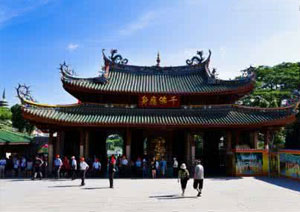The 1.78-square-kilometer Gulangyu Island in the southwestern corner of Xiamen is a major. With its serene beauty, tranquil atmosphere, fresh air, and buildings in various architectural styles tucked away in the shadows of green trees, there is plenty to see and do on this small island. It is the best place to visit in this part of Fujian, although it is sometimes hard to find a room, especially for those on a budget. Very few of the sights here are spoiled, and there are many charming features, from the profusion of ancient trees, all labeled, to the variety of seafood restaurants.
 At the northern end of the Gaoqi-Jimei Sea Dyke lies the town of Jimei. Encircled by the sea on three sides, the town is known for its magnificent buildings and picture-postcard scenery. Jimei is the hometown of Tan Kah-kee, who founded Xiamen University in 1913. He then went on to build a kindergarten, a science center, library and several other schools teaching various subjects, turning Jimei from a rural village into a sizeable town whose total student population of more than 100,000 exceeds that of local residents. As a tourist site, Jimei has many attractions.
At the northern end of the Gaoqi-Jimei Sea Dyke lies the town of Jimei. Encircled by the sea on three sides, the town is known for its magnificent buildings and picture-postcard scenery. Jimei is the hometown of Tan Kah-kee, who founded Xiamen University in 1913. He then went on to build a kindergarten, a science center, library and several other schools teaching various subjects, turning Jimei from a rural village into a sizeable town whose total student population of more than 100,000 exceeds that of local residents. As a tourist site, Jimei has many attractions.
South Putuo Temple Tourist Area
Situated at the foot of Wulao Peak on the southern end of Xiamen is South Putuo Temple. First built (618-907) and later rebuilt during the Qing dynasty (1644-1911), it is now an imposing multi-layered trapezoidal structure that overlooks the sea. The Shrine of  Buddhist Scriptures houses a large collection of Buddhist cultural relics, including a Burmese jade carving of the Buddha and many important Buddhist texts. The temple's Heavenly King Hall, the main prayer hall, the Hall of Great Compassion and the Shrine of Buddhist Scriptures are all graced with painted brackets and upturned eaves. The temple’s rare artifacts include four giant stone turtles lying on the right side of the front gate, a rock with holes in the shape of an ancient Chinese coin, a large Song dynasty bronze bell and a white porcelain sculpture of Guanyin, the Goddess of Mercy. The South Fujian Buddhist Institute is located to the left of the temple. Established in 1925, it enjoys great prestige among Buddhists in China.
Buddhist Scriptures houses a large collection of Buddhist cultural relics, including a Burmese jade carving of the Buddha and many important Buddhist texts. The temple's Heavenly King Hall, the main prayer hall, the Hall of Great Compassion and the Shrine of Buddhist Scriptures are all graced with painted brackets and upturned eaves. The temple’s rare artifacts include four giant stone turtles lying on the right side of the front gate, a rock with holes in the shape of an ancient Chinese coin, a large Song dynasty bronze bell and a white porcelain sculpture of Guanyin, the Goddess of Mercy. The South Fujian Buddhist Institute is located to the left of the temple. Established in 1925, it enjoys great prestige among Buddhists in China.
Nature is at its most impressive in this picturesque area. Only 500 meters southeast of the city proper, it is a major scenic spot known for its caves and egg-shaped granite rocks, which blend harmoniously with the flowers and trees of the botanical garden near Wanshi Lake. The Hongshan Amusement Park is also located here at the southwestern foot of the hill. This tourist area can be reached by bus from downtown Xiamen.
| Xining Attractions List | |

